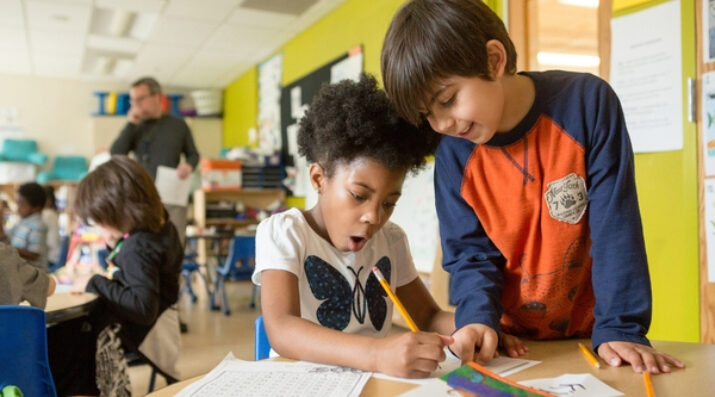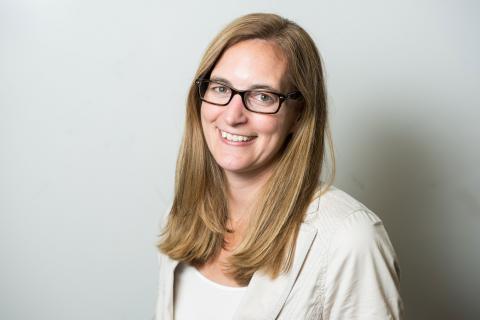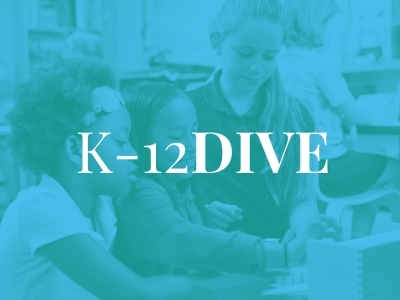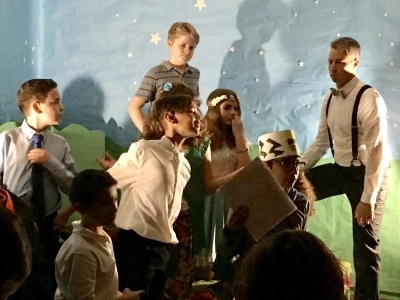How to Measure Success of a School Change Idea: Is It Working?
Topics

Today’s learners face an uncertain present and a rapidly changing future that demand far different skills and knowledge than were needed in the 20th century. We also know so much more about enabling deep, powerful learning than we ever did before. Our collective future depends on how well young people prepare for the challenges and opportunities of 21st-century life.
Iteration and refinement, student voice and participation, and meaningful measures can help schools know if their ideas to improve learning are making a difference for students.
At NGLC, we work with a lot of schools that want to improve learning for their students but don’t know where to start. We encourage them to start with a big, bold vision: What do they most want learning to be like for the students in their school? What do the youth in their community most need, and deserve, from their school?
We encourage schools to answer this question by gathering and exchanging ideas across all different members of their community: students, families, teachers, school and district administrators, school board members, local businesses, local government officials, community organizations, and others. Their answers might turn into a graduate portrait, a vision statement, or a Brave Question (a tool we use at NGLC in our programs). But however this big, bold vision for learning is expressed, what it becomes is a shared purpose to guide any effort to improve learning that follows.
With this vision in hand, the next step is not changing everything that needs to change in order for that vision to be realized. Instead, we help a small team (hopefully with a variety of community roles represented) get started by focusing on a single priority within that big, bold vision of learning—a priority that is again determined with broad community input. We help them select a change idea that is likely to have a noticeable impact on that priority, but doesn’t have barriers getting in the way.
This change idea becomes the team’s prototype. It’s usually something that requires limited resources—just a few people who are already involved, just a little bit of time, just a few existing materials and tools—and works within existing practices and policies. We like to call them “little bets.”
Here are some examples:
- One teacher tries a new lesson plan within an upcoming existing unit in one of her classes, to test some student-centered learning practices.
- A 5th grade team repurposes a scheduled assembly, an open space in the calendar that was in need of a more meaningful purpose, to introduce the district’s grad profile through hands-on activities.
- Two teachers lead restorative circles—an existing practice for students—but in an upcoming scheduled PD for teachers, to see if experiencing circles helps teachers feel more prepared to lead circles for students.
After teams test their prototype (or try to but run into challenges), we often get the question: How do we know if the change idea is working? How do we know if we’re on the right track?
Is the Change Idea Working?
First, it’s important to keep in mind that a prototype is about the change idea but it’s also not about the change idea. The specific prototype doesn’t matter as much as what a team learns from the experience of trying it. Because what they really want to do is get closer to that big, bold, ideal vision for learning. To do that, schools not only need to make changes, they also need to create the conditions and the culture that support those changes.
Here are three factors to consider.
Iteration and Refinement
Try your prototype a few times, tweaking it as you go. This allows you to test, observe, and refine your idea based on initial feedback and results. Someone once told me to try a new technology tool three times—making improvements each time—before deciding whether to keep using it or not. Three iterations can be a good starting point to see which aspects of the prototype have merit.
Communication with the whole school community as you iterate and refine the prototype is essential—starting from the very beginning and multiple times throughout, with multiple ways for people to connect. Communication is often thought of as information-sharing, but communication also involves listening and information-gathering. Providing updates to staff, students, families, and partners helps them see that your school is taking action based on their input. Continuing to ask for input, feedback, and suggestions opens the door to new perspectives and uncovers blind spots and unintended consequences. This is especially important to understand the impact on those whose voices traditionally haven’t been heard or involved in decision-making. It will help you improve the prototype as you iterate and help you learn more about what your community needs in order to reach that vision of learning.
Student Voice and Participation
Don't underestimate the importance of student involvement in your prototyping. Schools often look at student data and collect feedback from exit tickets or student surveys. Involving students in this way is a great practice. This kind of information is vital, but we’ve seen that feedback on an already developed idea leaves out so much opportunity. To design truly transformational learning, NGLC encourages schools to follow a principle we learned from the disability community: nothing about us without us. Consider this educator’s reflection:
“We intend on including our students in our professional learning activities moving forward—we are dumbfounded by our exclusion of them for the entirety of our professional careers when they represent the very work that we are doing.”
Involve some students as co-designers of a prototype, engaged equally in every activity and decision as all of the adults. Direct student engagement will reveal strengths, weaknesses, and areas for further improvement that might be overlooked by adults.
Meaningful Measures
Part of the prototype process is collecting data, feedback, and stories. What specific outcomes are you hoping to achieve with your change idea? What does success look like? Does the prototype move your school closer to the community’s big, bold vision for learning? Make sure to identify specific goals before trying the prototype so that you can collect the information you need to move your work forward.
We recommend measures about process/experience as well as outcomes. We include stories as a type of measure because it suggests a different kind of information than is usually considered “data.” Stories offer so much rich detail about the experiences that lead to the outcomes that are measured with quantifiable data. That detail can guide what to iterate and how to refine.
Data collection and analysis of both process and outcomes provides concrete evidence of student learning as well as how change happens in your school, even when things don’t go as planned. This helps teams understand if their actions are aligned to the big, bold vision for learning. Take these hypothetical reflections on a prototype; while hypothetical they do represent real change efforts in schools we’ve worked with this year:
Hypothetical Prototype A. “At first, students didn’t understand what we were asking them to do. We shifted halfway through and then students were able to at least complete a project. The end product didn’t turn out exactly like we hoped but they had fun and we did too!
- Outcome: All students completed a project but less than half met expectations. Students experienced joy in their learning.
- Implementation Insight: We learned that students need very clear instructions broken down into smaller steps to get through a complex project. They need more support to meet expectations, maybe showing an example of a final product would help. We know how to design interesting, engaging projects that students enjoy.
- Iteration: For the next group of students, we will provide instructions in smaller steps. Let’s also give them more time to explore the content and show an example of a final product so they understand our expectations. To make sure we don’t lose the joy as we make these changes, let’s invite a student who participated in the first prototype to help us re-design the lesson.
- Process Insight: The teachers were able to make a shift right in the moment when they noticed things weren’t working. Now we know we can tap into teachers’ quick-thinking, problem-solving expertise the next time we discover an unexpected challenge in our transformation work!
Hypothetical Prototype B. “We didn’t have time to meet to collaborate so we haven’t been able to plan the interdisciplinary project-based unit together and we haven’t taught it in our classes.”
- Outcome: None.
- Implementation Insight: There isn’t any time for teachers to collaborate during the school day. Let’s find a lower-constraint prototype that doesn’t require common planning time but still addresses our priority.
- Iteration: Let’s shift the prototype to something we can do on our own, focusing on the project-based elements of the unit and not the interdisciplinary elements, for now.
- Process Insight: Now we know that, before we can try any kind of interdisciplinary or co-taught projects, we need to set up structures that allow for common planning time.
- Iteration: Let’s brainstorm some ideas that create space for teacher collaboration. We can talk with school leaders about it and ask other teachers how they would use that time if it was available.
If the only measure these teams looked at was student outcomes, they would be missing so much important information about what works and what doesn’t. Important information that helps them understand what’s needed to get closer to their big, bold vision for learning they started this whole process with. These teams might think their prototype failed based on the “outcomes,” but I can see so much success in what they learned and how they applied that to their iteration. The process data they collected also sheds light on the assets (such as teachers’ problem-solving skills) and barriers (like lack of common planning time) to the change itself. All of these new insights can inform any and all change work on their vision for learning, not just the prototype.
Moving Your Change Idea Forward
By including these three factors—iteration and refinement, student voice and participation, and meaningful measures—in your prototype, you can make an informed decision about moving forward. Moving forward may mean transitioning to a pilot phase—a larger trial of your change idea, perhaps involving more people or a longer timeframe or with more constraints that need to be addressed. But moving forward also may mean circling back to the beginning to revisit the original change idea and coming up with a new prototype to try. Either way, you are taking steps to get closer to your school’s big, bold vision for learning.
Here are six questions to guide your decision:
- Impact: Does the prototype demonstrate potential to transform learning experiences in meaningful ways?
- Equity: Is there evidence that the prototype addresses historical inequities rather than reproducing them?
- Ownership: How much of your community has followed the prototype process? Have diverse stakeholders—staff, students, and key partners—expressed interest in participating in and owning the solution?
- Supportive Conditions: Does the prototype have the potential to influence broader systems-level elements, like policies, culture, and allocation of resources?
- Feasibility: Can the change idea be implemented more broadly while maintaining its core principles?
- Continuous Learning: Does the pilot design include robust mechanisms for ongoing input, feedback, and iteration from all stakeholders—staff, students, and key partners?
Whichever path you follow, your change idea is working when the learning you get from trying it informs your next steps. And it’s working when you take next steps rather than stall out. This is important to name and celebrate! Recognize the people who have been involved, highlight their contributions and what they learned—don’t be afraid to be transparent about the challenges and barriers—and celebrate the risk-taking and genuine care and commitment of the change-makers in your community.
With thoughtful decision making combined with celebratory storytelling, we know that schools are more likely to see their change efforts lead to long-term success and students who thrive.
Photo at top by Allison Shelley/The Verbatim Agency for EDUimages, CC BY-NC 4.0.




